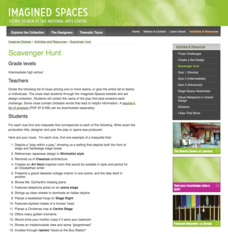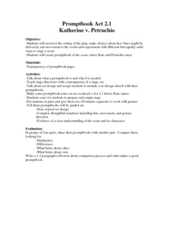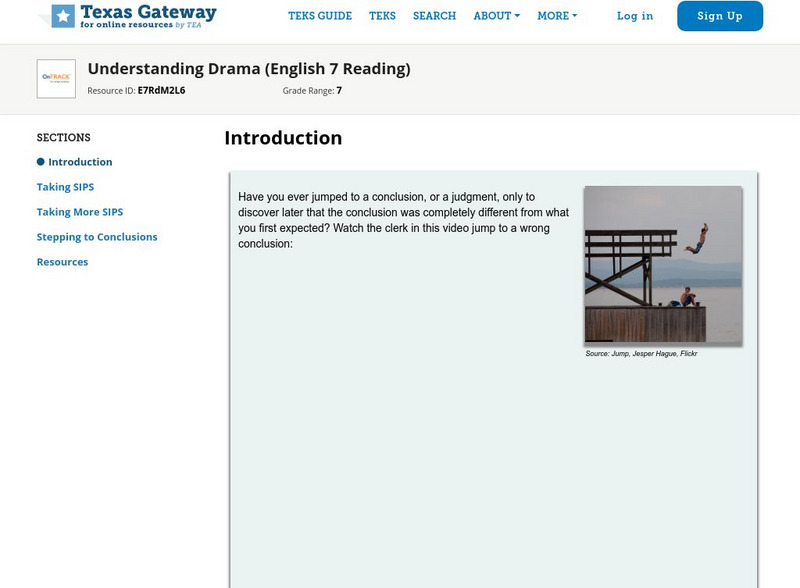AQA
Teaching Guide: Set Design
The task of creating a set for a theater production may leave theater arts students asking where to begin. Set their minds at ease with a packet that not only provides information about the elements of design, but also guides them...
Orange Public Schools
Stagecraft
The house lights dim, the curtain parts, lights slowly come up, revealing the stage. Before the actors appear, before a word is spoken, the audience is drawn in by the lighting, by the colors, by lines of the set, by the props, and...
Royal Shakespeare Company
King Lear Teacher Pack 2010
Every production of Shakespeare's plays is different—the director and designer must decide upon a theme. For his 2010 production, David Farr and his team decided to emphasize the conflicts that follow a regime change. The materials in a...
First Stage
A Charlie Brown Christmas
Charlie Brown may not feel the Christmas spirit this year, but your elementary students can use the season to practice important cross-curricular skills! A set of worksheets and activities based on A Charlie Brown Christmas guide apply...
University of Houston
The Snow Queen Study Guide
Even the kindest friends can become selfish and tyrannical in Hans Christian Andersen's "The Snow Queen." Class members complete story-themed exercises in language arts, social studies, and even physical science.
Teach It Primary
The Pied Piper of Hamelin
Six tasks make up a lesson plan designed to reinforce comprehension and language skills using the poem "The Pied Piper" by Robert Browing. Scholars discuss and define unknown words, identify adjectives and onomatopoeia, review complex...
Oxford Cambridge
Set and Prop Design
What's the difference between set dressing and a prop? Between a costume accessory and a personal prop? As part of their study of set and prop design, class members engage in a series of activities that prepare them to design a prop for...
National Arts Centre
Stage-Space Awareness
Introduce scenic designers to stage-space awareness with three fun activities that demonstrate how placement on the nine stage areas convey emphasis and clarify relationships.
Brigham Young University
Creating a Design Concept
Putting together information gained from their script analysis, their readings, and their research, groups create a conceptual design statement for their assigned scene. The statement explains how their scenic design creates the mood and...
Brigham Young University
Putting Ideas Together
As part of their study of set design, theater arts students put together what they have learned so far and create a thumbnail sketch of a set that they feel captures the style and mood they want to project.
National Arts Centre
Scavenger Hunt
Young theatre artists engage in a scavenger hunt to acquaint themselves with set design. The challenge is to search the site and match a separate maquette with each of the 24 clues.
Honors College at Scholar Commons
From Start to Strike: A Lesson Plan for the Whole Theatre Experience
Introduce young thespians to all aspects of the theater. A syllabus for a one-semester drama course provides lessons that take learners from the history of drama to the many facets of play production.
National Arts Centre
Create a Set Design
Groups create a set for a play or story they select, build a model, and share their stage with the class. The team explains the rationale for their choices and the mood they feel their staging creates.
Midland Independent School District
Drama
Ten drama lessons are the perfect addition to your language arts or theater class. With a focus on script elements, plot development, and parts of a dramatic story, the lessons guide young playwrights through the steps of telling a story...
Media Smarts
Scripting a Crime Drama
Develop novice script-writers. Small groups sift through a sample script, noting any script-writing conventions to share with the whole class. Using these conventions and plot structures, these groups compose a script for a 10-minute...
Curated OER
Analyzing Atmosphere: Macbeth Murder Scene and Dagger Speech
Shakespeare's Macbeth (Act II, Scenes I and II) lacks explicit details of the murder of King Duncan, yet the author creates an atmosphere that allows us to visualize the event. Readers interpret the "Dagger Speech" by writing stage...
Curated OER
ESL Network: Tezen, A Haitian Folktale
Sixth graders brainstorm various types of friendships prior to reading "Tezen," a tale about a young girl's friendship with a fish. After writing story reviews, they work in small groups to create dramatic skits based on the text and...
Curated OER
Enter Ophelia: Stage Directions, Promptbooks, and Film
Students review different film versions of the play, Hamlet, and compare what was presented to the actual stage directions given in the original Shakespearean version.
Curated OER
You Can't Go Home Again (or, If It's Not One Thing, It's Your Mother)
Students read a scene from Hamlet, without stage directions. They recreate the scene using their own stage directions as they see fit for the scene.
Curated OER
Promptbook Act 2.1: Katherine vs. Petruchio
Compile a promptbook with your young theater designers using a scene from Taming of the Shrew. The lesson outlines several activities, though it doesn't provide any examples of a promptbook or text from the play. Additionally, it...
Curated OER
Writing Drama-Trying Your Hand at being a Playwright
Fifth graders chart the elements of drama. In this performing arts lesson, 5th graders discuss the role of a playwrite, practice doing some Reader's Theatre scripts, write a paragraph about a problem between two people, and perform their...
Curated OER
Stage Directions Lesson Plan
Students examine and discuss stage directions, stage area layout, and body positions. They complete a stage directions and body positions worksheet, and draw the body positions for each stage area layout.
Curated OER
Stage Movement/ Blocking
Students work in teams of two to introduce stage directions/ blocking into a basic dialog using the program Hollywood High.
Texas Education Agency
Texas Gateway: Understanding Drama (English 7 Reading)
Learn how to explain a playwright's use of dialogue and stage directions.

























